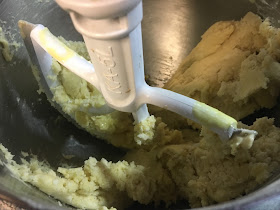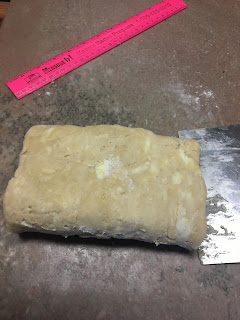So when I heard about a special event—Cows, Cooks and Conversation at Hildebrand Farms Dairy—I signed us up to attend. The cooking part featured electric pressure cooker tips and recipes with Chef Alli. Long story short—Barry and I gave a thumbs up to both of the recipes she prepared and I gained confidence + was inspired to begin experimenting. On the way back to Abilene from JC, we stopped and purchased needed supplies for both of Chef Alli's recipes + I've also made rice pudding since then.
Although Chef Alli recommends Cuisinart brand pressure cooker for its simplicity of use, I have finally figured out the bells and whistles on my brand . . . and discovered that electric models do not hiss!
Besides her own website (Chef Alli), she also recommended This Old Gal, Pressure Cooking Today, and Hip Pressure Cooking. I've been to all those sites and bookmarked recipes I want to try.
Below is the pasta recipe that we sampled in the class -- once the pressure cooker is pressurized (took about 20 minutes for our cooker), the "meal-in-one" cooks in just 5 minutes followed by quick release and then it's ready to eat. Also everything is done in just one pan so clean up is easy.
I used sour cream instead of cream and less than suggested; I also cut down on the amount of Parmesan. Other ideas: substitute sausage or ground turkey for ground beef and vary the type of pasta. Of course, peppers and mushrooms could be added or substitute Cheddar for the Parmesan for Cheeseburger Pasta; use salsa instead of marinara and give it a Mexican twist. The recipe is quite versatile and the ideas for change are endless.
By the way, the Hildebrand Farms Dairy tour was so educational and interesting. People of all ages were on the tour and everyone seemed to enjoy themselves. And, their milk is SO good!
Creamy Penned Pasta with Ground Beef
About 2 tablespoons olive oil
1 small yellow onion, diced3 cloves garlic, crushed
1 lb. lean ground beef (we used 85% lean)
1 teaspoon kosher salt
1/2 teaspoon black pepper
1 teaspoon Italian seasoning (I bumped it up to 1 tablespoon)
1/2 lb. mini penne pasta
24 oz. jar of marinara sauce (or homemade)
3 cups water (if broth is used, cut down on amount of salt added)
1 cup heavy whipping cream (I used about 1/2 cup of sour cream)
1 cup grated Parmesan cheese (I used less but more could also be added)
Fresh parsley for finishing if desired
- Set electric pressure cooker (EPC) to sauté setting, add olive oil to pot. When oil is hot (wait for the sizzle), add onions, garlic and ground beef, crumbling beef with a potato masher, cook until beef is no longer pink. Drain fat from pot if needed.
- Season beef with salt, pepper, and Italian seasoning, stirring gently to combine.
- Evenly pour shells over ground beef in EPC pot, then add the marinara sauce and water. DO NOT STIR! (Stirring could cause the mixture to begin thickening and if the contents are too thick, the pot may not pressurize.)
- Lock EPC lid into place (according to manufacture's directions) and choose High Pressure setting for 5 minutes.
- When timer sounds, perform a quick release to remove all pressure from EPC (manufacture's booklet will provide quick release instructions).
- Carefully remove lid, then stir in cream (or sour cream) and Parmesan. (Dairy is added at this stage as it curdles under pressure.) Note: the pasta and sauce will thicken as it sets.
- Finish by sprinkling with fresh parsley if desired.
Creamy Penned Pasta with Ground Beef
About 2 tablespoons olive oil
1 small yellow onion, diced
3 cloves garlic, crushed
1 lb. lean ground beef (we used 85% lean)
1 teaspoon kosher salt
1/2 teaspoon black pepper
1 teaspoon Italian seasoning (I bumped it up to 1 tablespoon)
1/2 lb. mini penne pasta
24 oz. jar of marinara sauce (or homemade)
3 cups water (if broth is used, cut down on amount of salt added)
1 cup heavy whipping cream (I used about 1/2 cup of sour cream)
1 cup grated Parmesan cheese (I used less but more could also be added)
Fresh parsley for finishing if desired
- Set electric pressure cooker (EPC) to sauté setting, add olive oil to pot. When oil is hot (wait for the sizzle), add onions, garlic and ground beef, crumbling beef with a potato masher, cook until beef is no longer pink. Drain fat from pot if needed.
- Season beef with salt, pepper, and Italian seasoning, stirring gently to combine.
- Evenly pour shells over ground beef in EPC pot, then add the marinara sauce and water. DO NOT STIR! (Stirring could cause the mixture to begin thickening and if the contents are too thick, the pot may not pressurize.)
- Lock EPC lid into place (according to manufacture's directions) and choose High Pressure setting for 5 minutes.
- When timer sounds, perform a quick release to remove all pressure from EPC (manufacture's booklet will provide quick release instructions).
- Carefully remove lid, then stir in cream (or sour cream) and Parmesan. (Dairy is added at this stage as it curdles under pressure.) Note: the pasta and sauce will thicken as it sets.
- Finish by sprinkling with fresh parsley if desired.




































